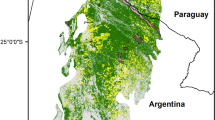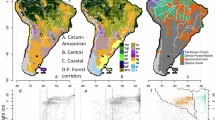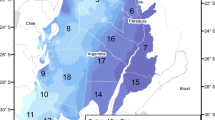Abstract
The lowlands of eastern and northeastern Bolivia are characterized by a transition between the humid evergreen forests of the Amazon Basin and the deciduous thorn-scrub vegetation of the Gran Chaco. Within this landscape lies one of the world’s best preserved areas: the ecoregion known as the Chiquitano dry forest, where deforestation patterns over a 30 year period were analyzed. Results indicate that the area of the natural cover was reduced from 97.21 % before 1976 to 82.10 % in 2008, causing significant change in the landscape, especially in the spatial configuration of forest cover. The density of forest fragments increased from 0.073 patches per 100 ha before 1976 to 0.509 in 2008, with a mean distance between patches of 151 and 210 m over the same period, leading to a considerable reduction in the fragment sizes, from 1,204 ha before 1976 to a mere 54 in 2008. This pattern, observed in forests, does not occur in the savannas because, on one hand the savanna area is much lower compared to that of forests, and on the other because the deforestation process tended to be concentrated within forested areas. Based on the observed patterns, it is possible that in the future the natural landscapes will be substituted principally by anthropic landscapes, if there is no change in the economic and land distribution policies. If this process continues, it will stimulate the expansion of mechanized agriculture and the colonization of new areas, which will lead to further deforestation and landscape fragmentation.



Similar content being viewed by others
Explore related subjects
Discover the latest articles and news from researchers in related subjects, suggested using machine learning.References
Achard F, Eva HD, Stibig HJ, Mayaux P, Gallego J, Richards T, Malingreau JP (2002) Determination of deforestation rates of the world’s humid tropical forests. Science 297:999–1002
Andersen LE, Mamani R (2009) Cambio climático en Bolivia hasta el 2100: síntesis de costos y oportunidades. ERECC-SA, CEPAL. 41 p
Angelsen A (2007) Forest cover change in space and time: combining the von Thünen and forest transition theories. World Bank Research Working Paper 4117. World Bank, Washington DC
Berbet MLC, Heil M (2003) Climate change after tropical deforestation: seasonal variability of surface albedo and its effects on precipitation change. J Clim 16:2099–2104
Bethell L (2008) The Cambridge history of Latin America: Latin America since 1930 spanish South America. Vol. 8. Cambridge University Press, Cambridge, UK, p 883
Bucher EH, Huszar PC (1999) Sustainable management of the Gran Chaco of South America: ecological promise and economic constraints. J Environ Manag 57:99–108
Camacho O, Cordero W, Martínez I, Rojas D (2001) Tasa de deforestación del Departamento de Santa Cruz 1993–2000. Superintendencia Forestal, BOLFOR. Santa Cruz de la Sierra, Bolivia. 43 p
Dale VH (1997) The relationship between land-use change and climate change. Ecol Appl 7:753–769
Dale VH, Brown S, Haeuber RA, Hobbs NT, Huntly N, Naiman RJ, Riebsame WE, Turner MG, Valone TJ (2000) Ecological principles and guidelines for managing the use of land. Ecol Appl 10(3):639–670
De Jong B, Ochoa-Gaona S, Castillo-Santiago M, Ramirez-Marcial N, Carins A (2000) Carbon flux and patterns of land-use/land-cover change in the Selva Lacandona, Mexico. Ambio 29(8):504–511
Dirmeyer PA, Shukla J (1994) Albedo as a modulator of climate response to tropical deforestation. J Geophys Res 99:20863–20877
Dirzo R, Garcia M (1992) Rates of deforestation in Los Tuxlas, a Neotropical area in southeast México. Conserv Biol 6(1):91–100
Eltahir EAB (1996) Role of vegetation in sustaining large-scale atmospheric circulations in the tropics. J Geophys Res 101:4255–4268
Fearnside PM (1995) Potential impacts of climate change on natural forest and forestry in Brazilian Amazonia. For Ecol Manag 78:51–70
Fearnside PM (2000) Global warming and tropical land use change: greenhouse gas emissions from biomass burning, decomposition and soils in forest conversion, shifting cultivation and secondary vegetation. Clim Chang 46:115–158
Fearnside PM, Laurance WF (2004) Tropical deforestation and greenhouse-gas emissions. Ecol Appl 14(4):982–986
Gascon C, Lovejoy TE, Malcom JR (1999) Matrix habitat and species richness in tropical forest remnants. Biol Conserv 91:223–229
Gavier GI, Bucher EH (2004) Deforestación de las Sierras Chicas de Córdoba (Argentina) en el período 1970–1997. Miscelánea Nº 101. Academia Nacional de Ciencias (Córdoba)
Grau HR, Gasparri NI, Aide TM (2005) Agriculture expansion and deforestation in seasonally dry forest of north-west Argentina. Environ Conserv 32(2):140–148
Hansen MC, Stehman SV, Potapov PV, Arunarwati B, Stolle F, Pittman K (2009) Quantifying changes in the rates of forest clearing in Indonesia from 1990 to 2005 using remotely sensed data sets. Environ Res Lett 4:1–12
Hecht S (2005) Soybeans, development and conservation on the Amazon frontier. Dev Chang 36(2):375–404
Houghton RA, Skole DL, Nobre CA, Hacler JL, Lawrence KT, Chomentowski WH (2000) Annual fluxes of carbon from deforestation and regrowth in the Brazilian Amazon. Nature 403:301–304
Huszar PC (1999) Justification for using soil conservation incentives. In: Sanders DW, Huszar PC, Sombatpanit S, Enters T (eds) Incentives in soil conservation: from theory to practice. Science Publishers, Enfield, pp 57–68
INE (Instituto Nacional de Estadística) (2005) Atlas estadístico de municipios: Bolivia un mundo de potencialidades. MDSP, COSUDE, PNUD, La Paz, 697 p
IPCC (2001) Climate change 2001: the scientific basis. Cambridge University Press
Kaimowitz D, Mendez P, Puntodewo A, Vanclay J (2002) Spatial regression analysis of deforestation in Santa Cruz, Bolivia. In: Wood CH, Porro R (eds) Land use and deforestation in the Amazon. University Press of Florida, pp. 41–65
Kates RW, Clark WC, Norberg-Bohm V, Turner II BL (1990) Human sources of global change: a report on priority research initiatives for 1990–1995. Discussion paper G-90-08. Global Environmental Policy Project, John F. Kennedy School of Government, Harvard University, Cambridge, Massachusetts, USA
Killeen TJ, Jardim A, Mamini FM, Rojas N, Saravia P (1998) Diversity, composition, and structure of atropical semideciduous forest in the Chiquitanía region of Santa Cruz, Bolivia. J Trop Ecol 14:803–827
Killeen TJ, Chavez E, Peña-Claros M, Toledo M, Arroyo L, Caballero J, Correa L, Guilleén R, Quebedo R, Saldías M, Soria L, Uslar Y, Vargas I, Steininger M (2006) The Chiquitano dry forest, the transition between humid and dry forest in Eastern Lowland Bolivia. In: Pennington (ed) Neotropical savannas and seasonally dry forests plant diversity biogeography and conservation. CRC Press, England, pp 213–233
Killeen TJ, Calderon V, Soria L, Quezada B, Steininger MK, Harper G, Solorzano LA, Tucker CJ (2007) Thirty years of land-cover change in Bolivia. Ambio 36(7):600–606
Killeen TJ, Guerra A, Calzadilla M, Correa L, Calderón V, Soria L, Quezada B, Steininger MK (2008) Total historical land-use change in eastern Bolivia: who, where, when, and how much? Ecol Soc 13(1):36
Laurance WF, Bierregaard RO Jr (1997) Tropical forest remnants: ecology, management, and conservation of fragmented Communities. The University of Chicago Press, Chicago, 528 p
Laverty MF, Gibbs JP (2007) Ecosystem loss and fragmentation. Lessons Conserv 1:72–96
Lawton RO, Nair US, Pielke RA, Welch RM (2001) Climatic impact of tropical lowland deforestation on nearby montane cloud forests. Science 294:584–587
Lord JM, Norton DA (1990) Scale and the spatial concept of fragmentation. Conserv Biol 4:197–202
Mahlman JD (1997) Uncertainties in projections of human caused climate warming. Science 278:1416–1417
McGarigal K, Romme WH, Crist M, Roworth E (2001) Cumulative effects of roads and logging on landscape structure in the San Juan Mountains, Colorado (USA). Landsc Ecol 16:327–349
Mertens B, Kaimowitz D, Puntodewo A, Vanclay J, Mendez P (2004) Modeling deforestation at distinct geographic scales and time periods in Santa Cruz, Bolivia. Int Reg Sci Rev 27(3):271–296
Meyer WB, Turner BL II (1994) Changes in land use and land cover: a global perspective. Cambridge University Press, Cambridge
Müller R, Müller D, Scheirhorn F, Gerold G (2010) Spatiotemporal modeling of the expansion of mechanized agriculture in Bolivia. Appl Geogr 31(2):631–640
Mulligan M (2000) Downscaled climate change scenarios for Colombia and their hydrological consequences. Adv Environ Monit Model 1(1):3–35
Murcia C (1995) Edge effects in fragmented forests: implications for conservation. Trends Ecol Evol 10(2):58–62
Naughton-Treves L (2004) Deforestation and carbon emissions at tropical frontiers: a case study from the Peruvian amazon. World Dev 32(1):173–190
Nepstad D, Carvalho G, Barros A, Alencar A, Capobianco J, Bishop J, Moutinho P, Lefebvre P, Lopes SU, Prins E (2001) Road paving, fire regime feedbacks, and the future of Amazon forests. For Ecol Manag 154:395–407
Nouvellon Y, Bégué A, Moran MS, Seen DL, Rambal S, Luquet D, Chehbouni G, Inoue Y (2000) PAR extinction in shortgrass ecosystems: effects of clumping, sky conditions and soil albedo. Agric For Meteoroly 105:21–41
O’Neill RV, Hunsaker CT, Timmins SP, Jackson BL, Jones KB, Riitters KH, Wickham JD (1996) Scale problems in reporting landscape pattern at the regional scale. Landsc Ecol 11:169–180
Pacheco P (1998) Estilos de desarrollo, deforestación y degradación de los bosques en las tierras bajas de Bolivia. Centro para los estudios laboral y agrario. La Paz. 376 pp
Pacheco P (2006) Agricultural expansion and deforestation in the lowlands Bolivia: the import substitution versus the structural adjustment model. Land Use Policy 23:205–225
Pacheco P, Mertens B (2004) Land use change and agricultural development in Santa Cruz, Bolivia. Boit et Forests des Tropiques 280(2):29–40
Pimm SL, Ayres M, Balmford A, Branch G, Brandon K, Brooks T, Bustamante R, Costanza R, Cowling R, Curran LM, Dobson A, Farber S, da Fonseca GAB, Gascon C, Kitching R, McNeely J, Lovejoy T, Mittermeier RA, Myers N, Patz JA, Raffle B, Rapport D, Raven P, Roberts C, Rodríguez JP, Rylands AB, Tucker C, Safina C, Samper C, Stiassny MLJ, Supriatna J, Wall DH, Wilcove D (2001) Can we defy nature’s end? Science 293:2207–2208
Pinto-Ledezma JN, Ruiz T (2010) Deforestación y fragmentación 1976–2006 en el municipio de San Julián (Santa Cruz, Bolivia). Ecología en Bolivia 45(2):101–115
Prado DE (2000) Seasonally dry forests of tropical South America: from forgotten ecosystems to a new phytogeographic unit. Edinb J Bot 57:437–461
Prado DE, Gibbs PE (1993) Patterns of species distributions in the dry seasonal forests of South America. Ann Mo Bot Gard 80:902–927
Seiler Ch (2009) Implementation and validation of a regional climate model for Bolivia. Friends of Nature Foundation, Santa Cruz de la Sierra, Bolivia. 38 p
Skole D, Tucker CJ (1993) Tropical deforestation and habitat fragmentation in the Amazon: satellite data from 1978 to 1988. Science 260:1905–1910
Solomon S, Qin D, Manning M, Chen Z, Marquis M, Avery KB, Tignor M, Miller HL (eds) (2007) Climate change 2007: the physical science basis. Working Group I Contribution to the Fourth assessment report of the Intergovernmental Panel on Climate Change. Cambridge University Press, Cambridge
Southworth J, Cumming GS, Marsik M, Binford MW (2006) Linking spatial and temporal variation at multiple scales in a heterogeneous landscape. Prof Geogr 58(4):406–420
Spies TA, Ripple WJ, Bradshaw GA (1994) Dynamics and pattern in management coniferous forest landscape in Oregon. Ecol Appl 4:555–568
Staus N, Strittholt J, Dellasala D, Robinson R (2002) Rate and pattens of forest disturbance in the Klamath-Siskiyou ecorregión, USA, between 1972 and 1992. Landsc Ecol 17: 455–470
Steininger MK, Tucker CJ, Ersts P, Killeen TJ, Villegas Z, Hetcht SB (2001) Clearence and fragmentation of tropical deciduous forest in the Tierras Bajas, Santa Cruz, Bolivia. Conserv Biol 15:856–866
Watson RT, Zinyowera MC, Moss RH (eds) (1997) The regional impacts of climate change: an assessment of vulnerability. Cambridge University Press, Cambridge
Watson RT, Noble IR, Bolin B, Ravindranath NH, Verardo DJ, Dokken DJ (2000) Land use, land-use change, and forestry. Cambridge University Press, Cambridge
Acknowledgments
We are grateful to the reviewers for their contributions. We thank Alex E. Jahn and Daniel Villarroel for helpful comments on earlier versions of this manuscript. We are also grateful to the Museo de Historia Natural Noel Kempff Mercado for sharing their extensive data set on deforestation. This manuscript was funded by the CNPq fellowship EXP-C (Projeto Sinergia-nº6 do CTHidro) to JNPL.
Author information
Authors and Affiliations
Corresponding author
Additional information
This article is part of a Special Issue on "Climate change and adaptation in tropical basins" edited by Pierre Girard, Craig Hutton, and Jean-Phillipe Boulanger.
Electronic supplementary material
Below is the link to the electronic supplementary material.
ESM 1
(DOCX 28 kb)
Rights and permissions
About this article
Cite this article
Pinto-Ledezma, J.N., Rivero Mamani, M.L. Temporal patterns of deforestation and fragmentation in lowland Bolivia: implications for climate change. Climatic Change 127, 43–54 (2014). https://doi.org/10.1007/s10584-013-0817-1
Received:
Accepted:
Published:
Issue Date:
DOI: https://doi.org/10.1007/s10584-013-0817-1




